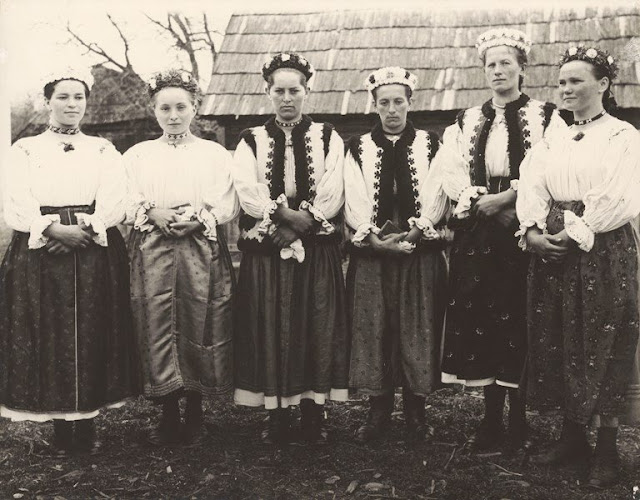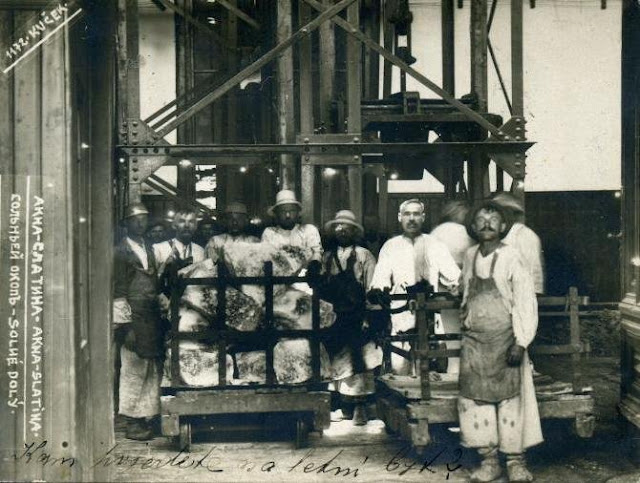Hello all,
Today I will conclude my overview of the Hutsul region by talking about the Hutsul and other Ukrainian villages in Maramureș, Romania. Here is a map showing the approximate extent of this region on an overall map of Hutsulshchyna.
The eastern part of this area is basically uninhabited. The Hutsul villages are found in the valley of the Ruskova [Ruscova] and Bistra Rivers. This valley is not connected directly to any of the other Hutsul regions. The Ruskova flows into the Bistra River, which in turn flows into the Tisa at the Ukrainian border. In the Ruskova River valley are found the villages Polyany [Poienile de sub Munte], Kryvyj [Repedea], and Ruskova [Ruscova]. On the Bistra river is found the village of Bystryj [Bistra] and a couple of satellite villages. All of these villages still have an absolute majority of Ukrainian inhabitants.
There are a few villages further west in Romanian Maramureș which are also still majority Ukrainian: Vyshnia Rivnia [Rona de Sus], Velykyj Bychkiv [Bocicoiu Mare], and Remeta [Remeți]. Other villages had inhabitants which are now Romanianized, or have a minority Ukrainian population. The Maramureș cultural region also extends north of the border, and there is a zone in Ukraine which wears Maramorosh style Folk Costume. This follows the old borders of Maramorosh, which also extended up the Teresva River Valley as far as the twin villages of Mokra.
The original folk costume of this area seems to be lost, and all now wear the Maramureș folk costume. Of the old costume I have found only two photos.
One from Polyany [Poienile de sub Munte]
And one from Vyshnia Rivnia [Rona de Sus]
What can we see of the old costume in these images? In the first one, we can see Hutsul type kyptars with large teeth along the front opening and patch pockets. The triple branched floral embroidery found in the lower front corner of the Rakhiv region is absent. Some of the women and girls are wearing woven wool vests instead. The married women are wearing kerchiefs, and the unmarried girls have braided their hair, and have either left their heads uncovered, or are wearing partas, open topped maiden's crowns. Some of the girls have a band of floral embroidery halfway down the sleeves, which is very unusual. Some of the shirts have the sleeves gathered into a narrow cuff, and others have the sleeve gathered a little way up, forming a fringed cuff. The double aprons have wide, very visible stripes, and some of the women are wearing plain dark gathered skirts. The men are wearing woven wool manty, and many are wearing white pants and boots. The girl in the second photo has her hair braided into a crown, and is wearing a sorochka which seems to be in Hutsul cut, with embroidery on the neckband, and nyzynka embroidery on the shoulders. She is also wearing a beaded necklace, gerdan, with Ukrainian lettering. Not enough of it is visible to read.
Here are some examples of the new costume in the Ukrainian villages.
These are firmly within the costume tradition of Maramureș, Marmorosh in Ukrainian. Here is a map of Maramureș county within Romania. You can see that the Ukrainian region is a significant part of it.
The Maramureș cultural region also extends north of the border, and there is a zone in Ukraine which wears Maramorosh style Folk Costume, including villages from Dilove to Nyzhna Apsha. There has historically been a mixed Ukrainian / Romanian population on both sides of the border, including the villages of Khmeliv,
Luh,
Velykyj Bychkiv / Bocicoiu Mare,
Krychuniv / Crăciunești,
Mykiv / Tisa,
Syhit / Sighetu Marmației,
Bila Tserkva,
Solotvyno,
Seredne Vodyane,
Remety / Remeți,
and others.
The chemise of this region has a unique cut, not resembling that of other Ukrainian or Romanian chemises, except for the region immediately to the west.
There is a narrow strip of embroidery on the shoulders, around the square neck opening, on the front and rear of the neck yoke, and the cuffs. A frill, or epaulette, is sewn into the shoulder seam.
Over the chemise, the original lower body wear consisted of double aprons in wool, with wide, contrasting stripes of red, yellow, green, or pink alternating with black.
But for the most part, they have been replaced by skirts of floral or other materials by Ukrainians. See also the vintage photographs above.
Note the woman on the left, who seems to be the mother of one of the girls in the procession.

Note the white wool socks and postoly.
The kyptars, or sheepskin vests, used in this region have the same simple cut as in other Hutsul areas, but may have one of three different ornamental patterns. The first is relatively plain, with simple applique around the edges. Examples from Velykyj Bychkiv / Bocicoiu Mare.

A second version involves this applique, but also includes multicolored tassels, which move when dancing. This seems to have come from further south in Romania, and is relatively rare in this region. A couple of examples from Solotvyno.
The third style is covered with elaborate embroidery and applique all over. The first example is from Bedevlya.
I have a vest like this in my personal collection, but it is packed away and Im afraid that the moths have eaten it.
Vests of plain heavy wool were also worn.
The men wear somewhat similar shirts with embroidery on the shoulders and cuffs.
The shirts of cotton or linen often had wide open sleeves, and were accompanied by woven or knitted wrist warmers.
Wide open bottomed linen or cotton pants were worn in summer, and heavy wool pants in winter over them. White socks and moccasins, postoly were originally worn, but replaced by boots by those who could afford them.
And that concludes this series on Hutsul costume. Thank you for reading, I hope that you have found this to be interesting and informative.
Roman K.
email: rkozakand@aol.com
Source Material:
Ortansa Dogaru, 'Ornamentele si Croiul Costumului din Maramures', 1976
Florea Bobu Florescu, 'Portul Popular din Moldova de Nord', Bucarest, 1991
Tancred Bănățeanu et al, 'Arta Populara in Republica Populara Romina', Sibiu, 1955
Yaroslava Kozholianko, 'Traditional Dress of Bukovyna', Chernivtsi, 1994
Eric Kolbenheier, 'Specimen Embroideries of the Peasant Home Industry in the Bucovina', 1974 Canadian reprint.
A. O. Kratiuk et al, 'The Kolomyja Museum of Hutsul Folk Art', Kyjiw, 1991
Stepan Pavliuk et al. 'Etnohrafixhni Hrupy Ukrajintsiw Karpat - Hutsuly', Kharkiw, 2020
Olena Nykorak et al, 'Hutsul's'ka Vyshywka', Rodovid, 2010
Olena Kul'chyts'ka, 'Narodnyj Odiah Zakhidnykh Oblastej Ukrajiny', reprint L'viw, 2018
Roman Reinfuss, 'Karpacki Swiat Bojkow i Lemkow', Krakow, 2016
Hryhorij Smol'skyj, 'Kosmats'ki Vustawky', L'viw, 2001
Alicja Wozniak, 'Wyrozniemi Strojem - Huculszczyna Tradycja i Wpolczesnosc', Lodz, 2012
Mykola Domashews'kyj, Istoria Hutsulshchyny', Chicago, 1975
Myroslava Shandro, 'Hutsul's'ki Vyshywky', Cherniwtsi, 2010
Iryna Svjontek, 'Hutsuls'ki Vyshywky Karpat, vol 3', Ivano Frankiwsk, 2008
Iryna Svjontek, 'Hutsuls'ki Vyshywky Karpat, vol 4-5', L'viw, 2016
Iryna Karpynets', 'Keptari Ukrajins'kykh Karpat', L'viw, 2003
Eudokia Sorochaniuk, 'Nyzynka - Embroidery of the Hutsuls, Pennsauken, NJ, 2002
V. H. Zabolotnyj et al. 'Ukrajins'ke Narodne Dekoratyvne Mystetsvo', Kyjiw 1956
Tetyana Kara Vasylieva, 'Ukrajins'ka Vyshywka', Kyjiw 1993
Romana Labrosse et al, 'Timeless Treasures', New York, 2018
Yevhen Shevchenko, 'Yevhenia Henyk', Kyiv 2007



.png)
..jpg)






.png)
.png)
.png)
.png)
.png)

.jpg)
.jpg)


.jpg)



.jpg)


.jpg)
,%20%D0%BF%D0%BE%D0%B2%D1%96%D1%82%20%D0%9C%D0%B0%D1%80%D0%B0%D0%BC%D1%83%D1%80%D0%B5%D1%88,%20%D0%A0%D1%83%D0%BC%D1%83%D0%BD%D1%96%D1%8F..jpg)
.2.jpg)
.jpg)







.png)
.png)
.png)
.png)
.png)
.png)
.png)
.png)
.png)

























.png)
.png)
.png)
.png)




.jpg)













.png)
.png)





.jpg)

















Dear Roman,
ReplyDeleteI just wanted to let you know that this is an absolutely amazing blog / website you've made, and that your work is truly appreciated. Your blogposts lead me to not only developing an interest in my ancestry, but also immensely expanded my world. Cultures I had no idea had such depth or even existed turned out to border even more more such cultures. I was shocked to find out so many cultural identities existed, *everywhere*, and how differently they expressed themselves.
Thank you.
Dear Roman: I heard that sigh of relief as you published this last post - what an effort! And worth it completely - you have given us so much wonderful information. Thank you.
ReplyDeleteThis area seems to be the only place where wristwarmers were worn - I known they are - or were- common in Scandinavia but I don't recall noticing them in your Hutsul posts. Did I miss something or were they only common in this particular area? Thanks again for the information and research. Charlotte in California
Wrist warmers are not, in fact, found in Hutsul costume. They are used here, in lowland Transcarpathia, with costumes that have wide open sleeves, and into Romania and Slovakia. Hutsul costumes mostly have closed cuffs on their shirts.
DeleteThank you for the wristwarmer information - I'll have to prowl through other posts. Interesting that they caught on in just that one tiny area. Charlotte in California
ReplyDeleteI think that you misunderstand. Wrist warmers are common throughout the Pannonian cultural region, which are the plains southwest of the Carpathians, from Transylvania to Slovakia. They exist in Ukrainian culture only in lowland Transcarpathia, between the Tisa and the mountains, but they come from the south. They are found here under the influence of their southern and western neighbors, they did not somehow develop independantly here.
DeleteA fascinating and informative post and beautiful photos.
ReplyDeleteIt was really informative...AO
ReplyDeleteYour website is useful. Thank you for sharing!...AO
ReplyDeleteWow, this post is fastidious...AO
ReplyDeleteThis website was Relevant!! Finally I have found something which helped me. Thank you!...AO
ReplyDeleteThank you for this very insightful article!!! I am planning a trip to Ukraine and Romania to explore Hutsul culture more deeply, and your article helped me to focus on specific regions in Romania. Thank you so much, and I would love to continue a conversation with you and learn more 🙏
ReplyDelete